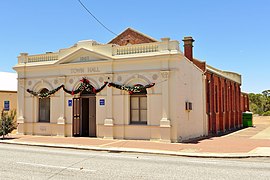Shire of Pingelly
| Shire of Pingelly Western Australia | |||||||||||||||
|---|---|---|---|---|---|---|---|---|---|---|---|---|---|---|---|
 Pingelly Town Hall, 2014 | |||||||||||||||
 Location in Western Australia | |||||||||||||||
| Population | 1,146 (2016 census)[1] | ||||||||||||||
| • Density | 0.8852/km2 (2.2927/sq mi) | ||||||||||||||
| Established | 1891 | ||||||||||||||
| Area | 1,294.6 km2 (499.8 sq mi) | ||||||||||||||
| Mayor | William Mulroney | ||||||||||||||
| Council seat | Pingelly | ||||||||||||||
| Region | Wheatbelt | ||||||||||||||
| State electorate(s) | Central Wheatbelt | ||||||||||||||
| Federal Division(s) | O'Connor | ||||||||||||||
 | |||||||||||||||
| Website | Shire of Pingelly | ||||||||||||||
| |||||||||||||||
The Shire of Pingelly is a local government area in the Wheatbelt region of Western Australia, about 160 kilometres (99 mi) southeast of the state capital, Perth, between the Shires of Brookton and Cuballing along the Great Southern Highway. The Shire covers an area of 1,295 square kilometres (500 sq mi), and its seat of government is the town of Pingelly.
History[]
On 24 December 1891, the Morambine Road District was created. On 21 February 1913, it was renamed the Pingelly Road District. On 1 July 1961, it became a Shire following the passage of the Local Government Act 1960, which reformed all remaining road districts into shires.[2]
Wards[]
From 20 October 2007, Pingelly is no longer divided into wards, and its 8 councillors represent the entire shire.
The ward systems created under successive divisions were as follows:[2]
| 1921 | 1986 | 1992 | 2003 |
|---|---|---|---|
| Pingelly Ward (3) | Pingelly Ward (4) | Town Ward (4) | |
| Central Ward (2) | Mourambine Ward (1) | Hotham Ward (1) | Hotham Ward (2) |
| Noonebin Ward (1) | Jingaring Ward (1) | Jingaring Ward (2) | |
| North East Ward (1) | Kulyaling Ward (1) | Kulyaling Ward (2) | |
| North West Ward (1) | Tutanning Ward (1) | Tutanning Ward (2) | |
| South East Ward (1) | |||
| South West Ward (1) | |||
Towns and localities[]
- Pingelly
- Boyagin
- Dattening
- Kulyaling
- Moorumbine
Population[]
| Year | Population |
|---|---|
| 1911 | 1,879 |
| 1921 | 1,644 |
| 1933 | 1,496 |
| 1947 | 1,230 |
| 1954 | 1,519 |
| 1961 | 1,639 |
| 1966 | 1,453 |
| 1971 | 1,447 |
| 1976 | 1,446 |
| 1981 | 1,410 |
| 1986 | 1,371 |
| 1991 | 1,171 |
| 1996 | 1,132 |
| 2001 | 1,122 |
| 2006 | 1,168 |
| 2011 | 1,163 |
Notable councillors[]
- George Sewel, Pingelly Roads Board member 1904–1915, chairman 1914–1915; later a state MP
Heritage-listed places[]
As of 2021, 72 places are heritage-listed in the Shire of Pingelly,[3] of which two are on the State Register of Heritage Places.[4]
| Place name | Place # | Street name | Suburb or town | Co-ordinates | Built | Stateregistered | Notes & former names | Photo |
|---|---|---|---|---|---|---|---|---|
| Pingelly Post Office | 2252 | 9 Parade Street | Pingelly | 32°32′02″S 117°05′02″E / 32.53387°S 117.083868°E | 1893 | 7 October 1997 | 
| |
| CBH Bins, Pingelly | 5934 | Quadrant Street | Pingelly | 32°31′24″S 117°04′50″E / 32.523338°S 117.080689°E | 1962 | 1 August 2006 |
References[]
- ^ Australian Bureau of Statistics (27 June 2017). "Pingelly (S)". 2016 Census QuickStats. Retrieved 28 October 2019.

- ^ Jump up to: a b "Municipality Boundary Amendments Register" (PDF). Western Australian Electoral Distribution Commission. Retrieved 11 January 2020.
- ^ "Shire of Pingelly Heritage Places". inherit.stateheritage.wa.gov.au. Heritage Council of Western Australia. Retrieved 27 March 2021.
- ^ "Shire of Pingelly State Register of Heritage Places". inherit.stateheritage.wa.gov.au. Heritage Council of Western Australia. Retrieved 27 March 2021.
External links[]
- Populated places established in 1891
- 1891 establishments in Australia
- Shire of Pingelly
- Local government areas of the Wheatbelt region of Western Australia
